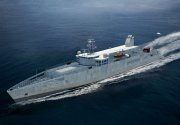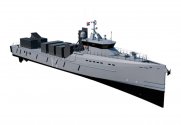FFG-62 will have 3 fixed arrays allowing for scanning in both horizontal and vertical planes.Constellation rotating faces
You are using an out of date browser. It may not display this or other websites correctly.
You should upgrade or use an alternative browser.
You should upgrade or use an alternative browser.
054B/new generation frigate
- Thread starter Blitzo
- Start date
A fixed phased array radar does both horizontal and vertical scans on the same face. It's rate of update is determined electronically.
On a rotating phase or planar array radar, the radar does a vertical scan electronically but the horizontal scan is done mechanically through the radar's rotation. That puts a mechanical limit to your update rate, unless the radar does a counterclockwise horizontal scan. Putting two faces instead of one, like you see in SAMPSON and Heracles, and what's likely on the 054B radar, doubles the rate of horizontal update from the rate of revolution.
A rotating AESA doesn't require the horizontal scan to be done mechanically -- for many more modern AESA types, they are just regular 3D AESA arrays put on a rotating mount to enable 360 degree coverage.
A rotating AESA doesn't require the horizontal scan to be done mechanically -- for many more modern AESA types, they are just regular 3D AESA arrays put on a rotating mount to enable 360 degree coverage.
There are different operating modes. This should be one of them, if not the main one for volume search, as it enables 360 coverage and is the easiest to do, as the method goes back to over half a century, making it highly proven and trusted. A phase array loses transmission gain when the beam is steered left and right, the farther off center the greater the loss. To retain as much gain as possible, the array should have minimal electronic steer, and you let the array be mechanically steered. This works best if the radar is in volume search mode for the longest range possible.
The scanning pattern of a search radar looks like the shape of an oyster shell. With four panels, it's like arranging four oysters in a cross not unlike a four leaf cover. The range distribution is not equal as there will be a drop off in between the lobes of each panel as the beam is steered away off bore from the plane of the array. But with a rotating radar, the distribution is equal, and you have a perfect circle where every part in the 360 degree gets equal strength.
Last edited:
Most likely not realistic in this hull. If she does use IEP propulsion as rumored, most of the extra space in this modified hull would go to additional generators and energy storage plus a bit in the back for a larger helo deck. Dabao's comparison CG showcases this very well. The change to GT+diesel also required a complete redesign of the exhausts and GT exhausts take up more space already. The additional machinery and energy generator/storage midship make it impossible to install VLS there, a frigate just does not have that deep a hull.
View attachment 115222
I mean I guess you could lengthen and widen the hull further but then we go dangerously into the questions of "Why not just start over with a new hull" and "Why not just build an actual destroyer"? From what we know PLAN doesn't need the largest frigate that carries the most VLS or most lethal complement of anti-ship missiles, they just need a more awesome 054A, i.e., a frigate.
Not sure about the second mast. I think it's more likely what other models have shown, there is a smaller two sided AESA there running at a higher frequency, this being the radar from the Type 075.
One of the mast, possibly the first one and main one, would have four rectangular arrays around each side. This is the CEC arrays.
There's a question on the ECM and ESM arrays too, whether they will use the same design as per 055 and 003 where two large panels are in each side of the super structure.
It's possible that the ship will have AESA missile target illuminators which also act as tracking radars, for HHQ-16 use.
It's important to see how the radar configuration of the 054A works and I think the 054B follows this main principle.
Type 382. Main search radar, dual sides, revolving at 30 rpm. Volume air search. Each side appears to have different bands.
Type 364 secondary surface search radar rotating at 60 rpm. Designed to detect and track antiship missiles.
It's possible with data fusion that the tracking output of both radars are combined for a higher quality track.
Type 366 antiship radar with over the horizon capabilities. Said to be able to detect low flying objects beyond the horizon. This is used to engage with the YJ-83.
Four Front Domes. The type 382 and 364 serves to queue these radars to the target where higher quality tracking is done while simultaneously illuminating the target for missile engagement.
The Type 364 serves to also queue the three Type 347G gunnery radars for 76mm gun and CIWS engagement. One Type 347G serves the main gun on top of the bridge, two Type 347G attached on top of the Type 730/1130 CIWS.
The design of the Type 054A allows simultaneously tracking and engaging targets with separate multiple fire control radars in all quadrants without tying up the main air search and secondary surface search radar. The ship doesn't lose its situational awareness and hence multitasking onboard using it's different radars.
By 366 did you mean 344?Not sure about the second mast. I think it's more likely what other models have shown, there is a smaller two sided AESA there running at a higher frequency, this being the radar from the Type 075.
One of the mast, possibly the first one and main one, would have four rectangular arrays around each side. This is the CEC arrays.
There's a question on the ECM and ESM arrays too, whether they will use the same design as per 055 and 003 where two large panels are in each side of the super structure.
It's possible that the ship will have AESA missile target illuminators which also act as tracking radars, for HHQ-16 use.
It's important to see how the radar configuration of the 054A works and I think the 054B follows this main principle.
Type 382. Main search radar, dual sides, revolving at 30 rpm. Volume air search. Each side appears to have different bands.
Type 364 secondary surface search radar rotating at 60 rpm. Designed to detect and track antiship missiles.
It's possible with data fusion that the tracking output of both radars are combined for a higher quality track.
Type 366 antiship radar with over the horizon capabilities. Said to be able to detect low flying objects beyond the horizon. This is used to engage with the YJ-83.
Four Front Domes. The type 382 and 364 serves to queue these radars to the target where higher quality tracking is done while simultaneously illuminating the target for missile engagement.
The Type 364 serves to also queue the three Type 347G gunnery radars for 76mm gun and CIWS engagement. One Type 347G serves the main gun on top of the bridge, two Type 347G attached on top of the Type 730/1130 CIWS.
The design of the Type 054A allows simultaneously tracking and engaging targets with separate multiple fire control radars in all quadrants without tying up the main air search and secondary surface search radar. The ship doesn't lose its situational awareness and hence multitasking onboard using it's different radars.
There are different operating modes. This should be one of them, if not the main one for volume search, as it enables 360 coverage and is the easiest to do, as the method goes back to over half a century, making it highly proven and trusted. A phase array loses transmission gain when the beam is steered left and right, the farther off center the greater the loss. To retain as much gain as possible, the array should have minimal electronic steer, and you let the array be mechanically steered. This works best if the radar is in volume search mode for the longest range possible.
The scanning pattern of a search radar looks like the shape of an oyster shell. With four panels, it's like arranging four oysters in a cross not unlike a four leaf cover. The range distribution is not equal as there will be a drop off in between the lobes of each panel as the beam is steered away off bore from the plane of the array. But with a rotating radar, the distribution is equal, and you have a perfect circle where every part in the 360 degree gets equal strength.
Yes, my point is to illustrate that it's still ultimately a 3D AESA that is mechanically rotated. In terms of its 360 degree coverage, that is due to mechanical rotation. However, it should retain all of the functions of a regular 3D AESA.
I.e.: hypothetically speaking, if its mechanically rotated mount were to malfunction, the array will still be fully functional in the hemisphere it is now fixed and pointed towards.
De facto, i suspect that in case of an actual surface action(avare surface ships, not an ambush), the main weapon of Constellation class will be sm-2MR blk.3, not the NSM.
Do you mean the SM-6 Block IB? That one is hypersonic, active radar (AIM-120 based) with anti-ship capability (does it have an image seeker?).
Last edited:
I wonder if future HQ-16 variants would have anti-ship capabilities like the SM-2 series.NSM is half as light as yj-83/harpoon. It's in penguin class(i.e. helicopter ASM), not a direct harpoon follow-on.
It is a specific adaptation against small/coastal, potentially numerous(including unmanned) targets which missile may need to filter out of noise/background/traffic itself. Subsonic& Imaging-ir NSM is ideally positioned to do just that. In addition, it will seriously conpromise effectiveness of the smallest chinese naval SHORAD missile system(low IR signature, no emissions).
Number of missiles here comes from its weight, but also it is done to allow captain to fire single shots and small salvos without any second thoughts. Missiles are many, NSM launch doesn't really send missile all that high=IR signature of the launch(compromising launch location) is minimal.
De facto, i suspect that in case of an actual surface action(avare surface ships, not an ambush), the main weapon of Constellation class will be sm-2MR blk.3, not the NSM.
YJ-12 is a direct opposite, a large weapon designed specifically for massed use (often as a coordinated salvo of multiple ships) against distinctive and large surface targets in high seas warfare. In this case, situation is the opposite: against smaller/local surface targets, ship commander will probably opt for a SAM.
I wonder if future HQ-16 variants would have anti-ship capabilities like the SM-2 series.
Chances are they are already capable of doing so, as are other PLAN medium or long range SAMs.
Adding another 16 or even 32(!) VLS at the aft means that you might as well build another 052D/DL.A smarter design would simply involve adding additional 16-32 VLS in the rear.
A destroyer-like armament on a hull with only frigate-like capabilities isn't really worth it.
If you want more firepower to become available to the 054Bs (or just about any major surface combatant of the PLAN), attaching each of those ships with one or two of something like this:

(Large Unmanned Surface Vessel (LUSV) for the US Navy)
Or even something like this:

(The Rapidly Increased Firepower Capability (TRIFIC) for the Royal Netherlands Navy)
... would be a better allocation of budget and resources available to the PLAN, TBH.
Last edited:
